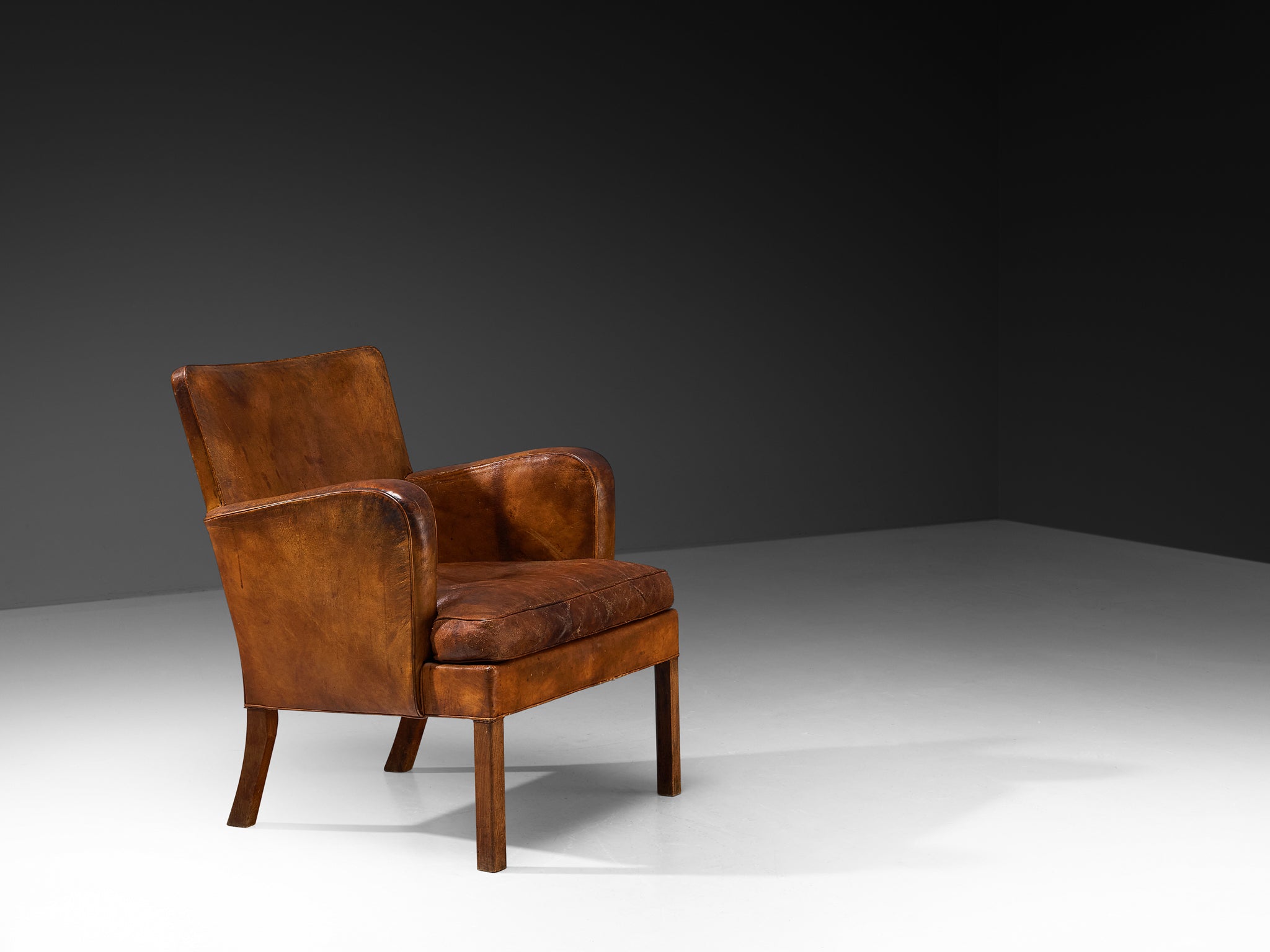
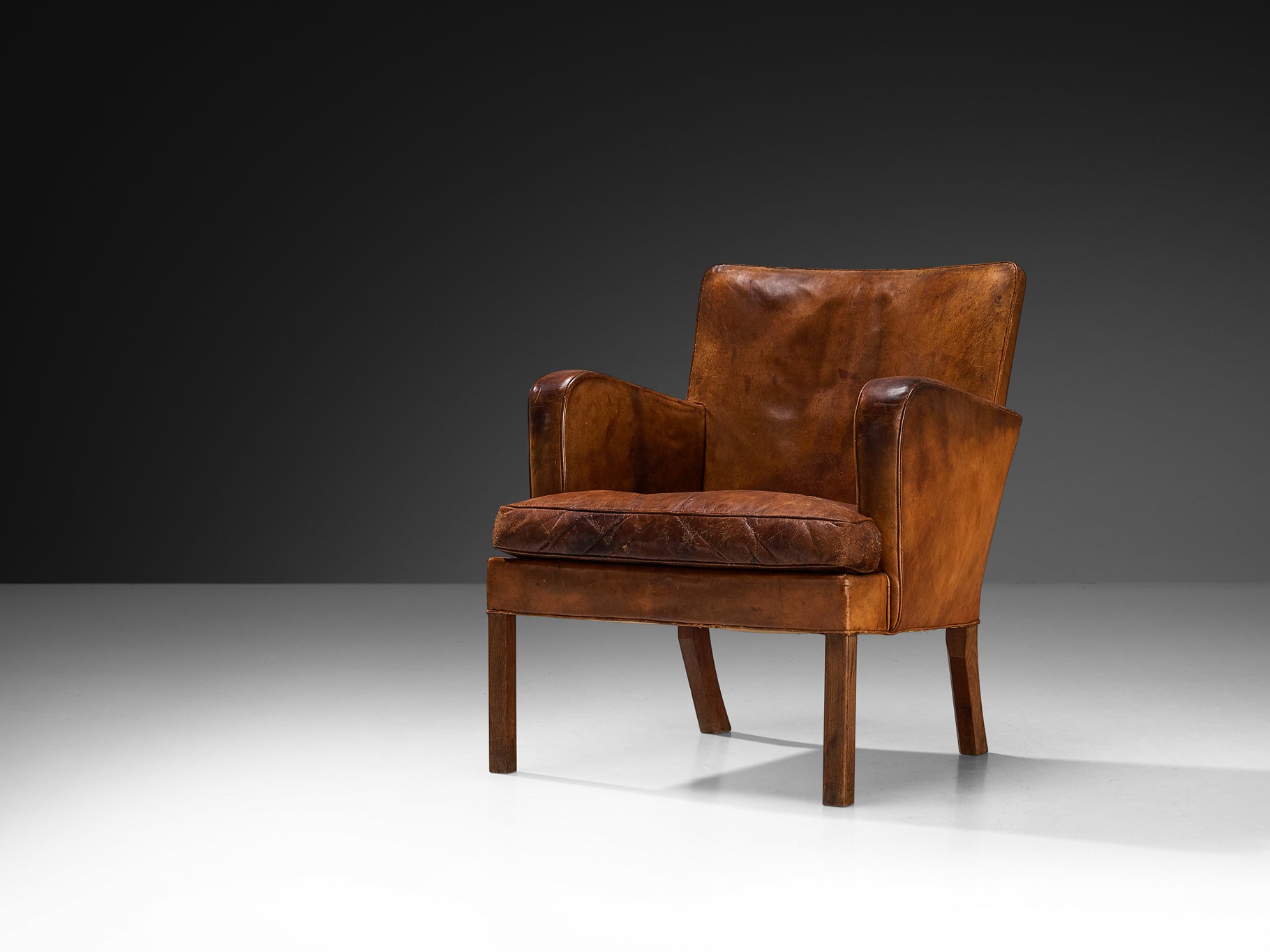
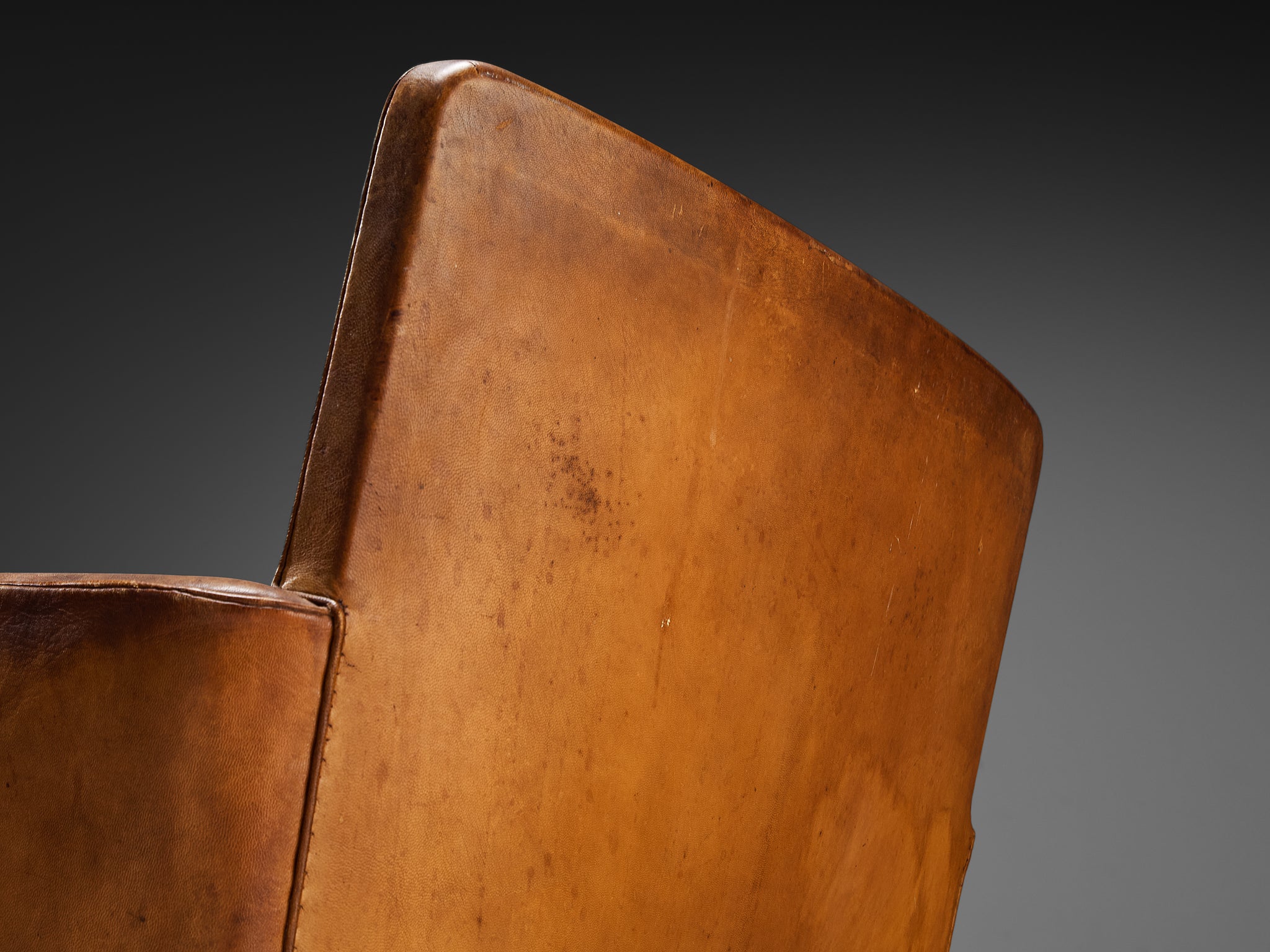

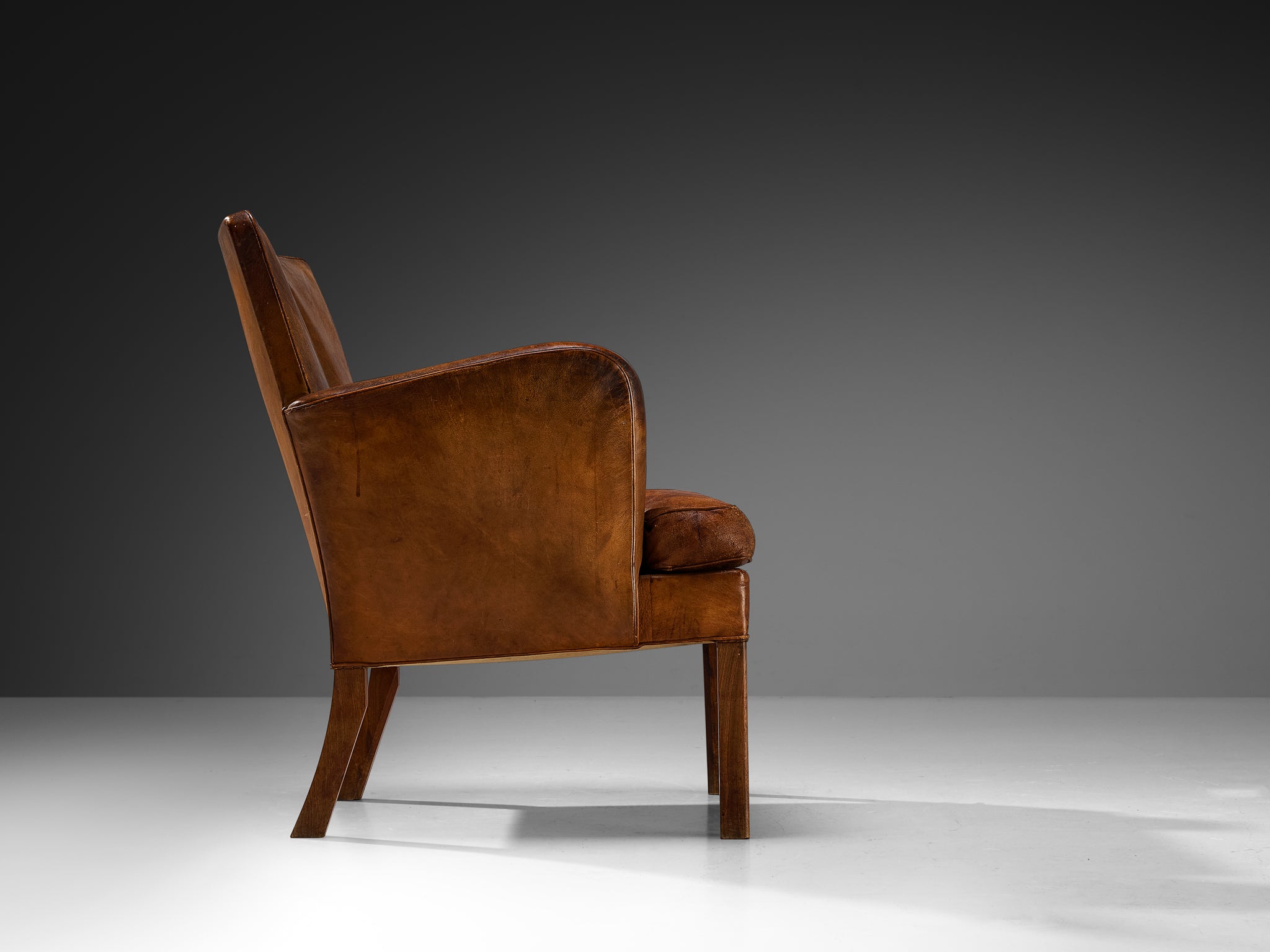
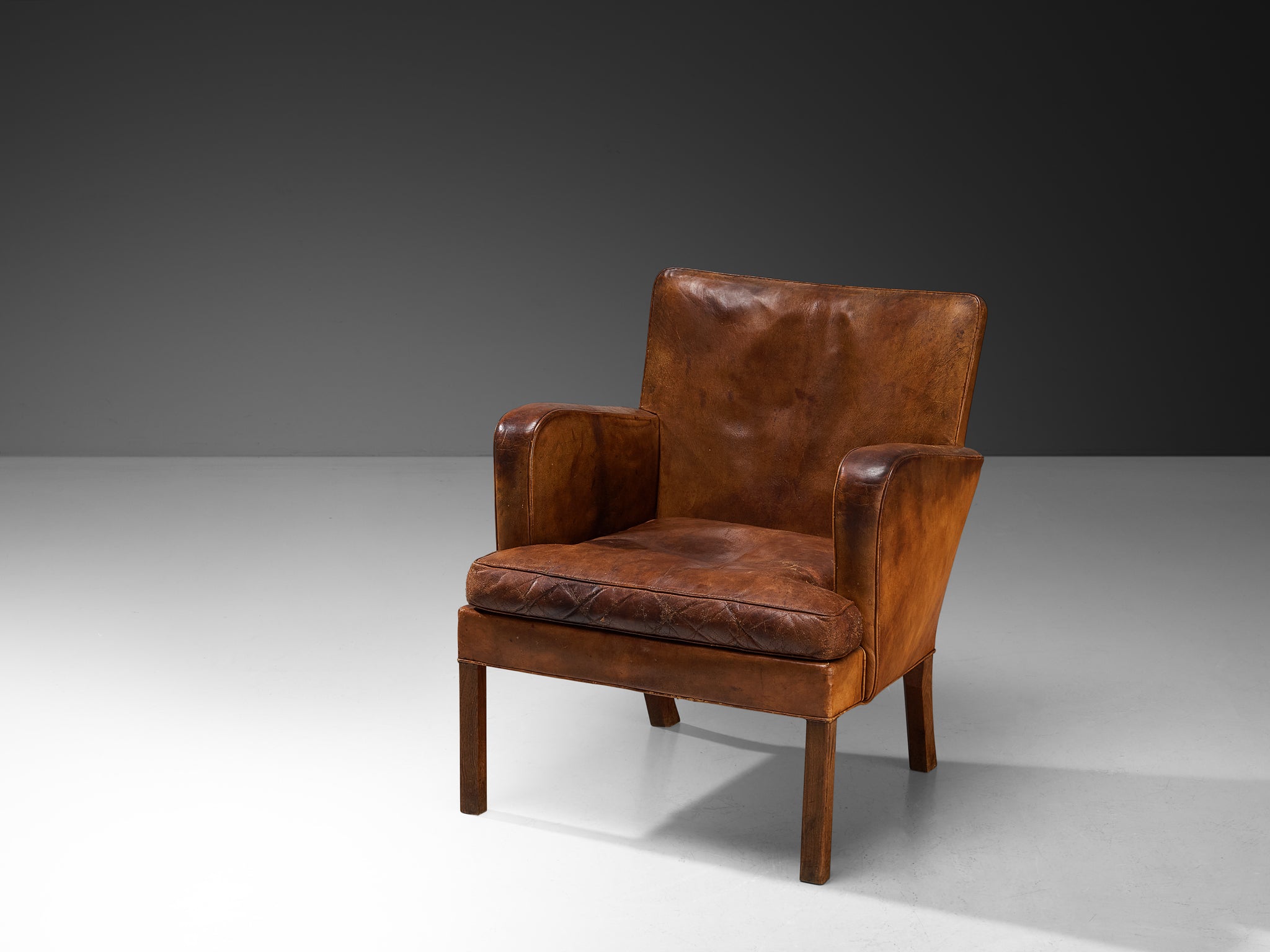
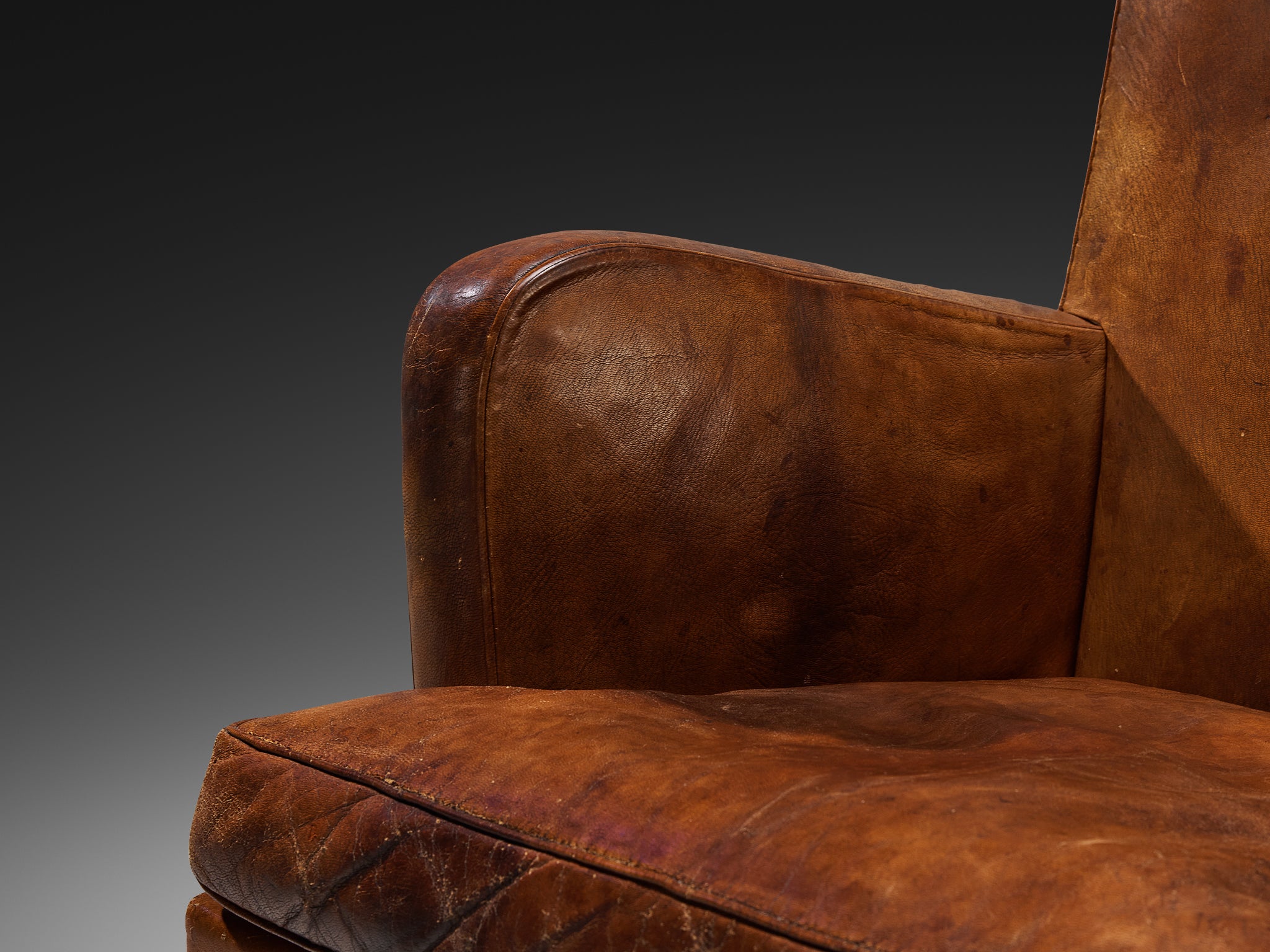
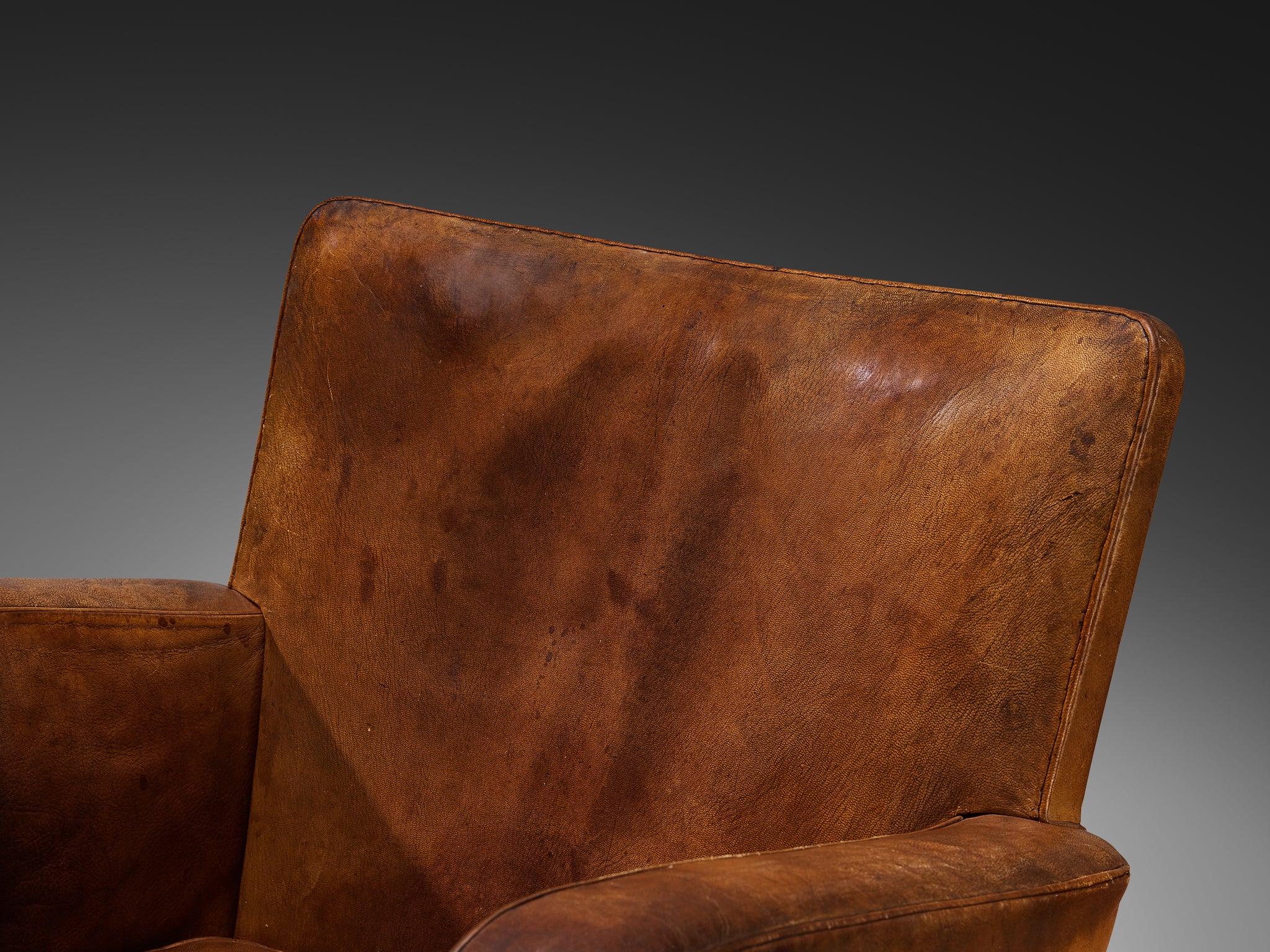

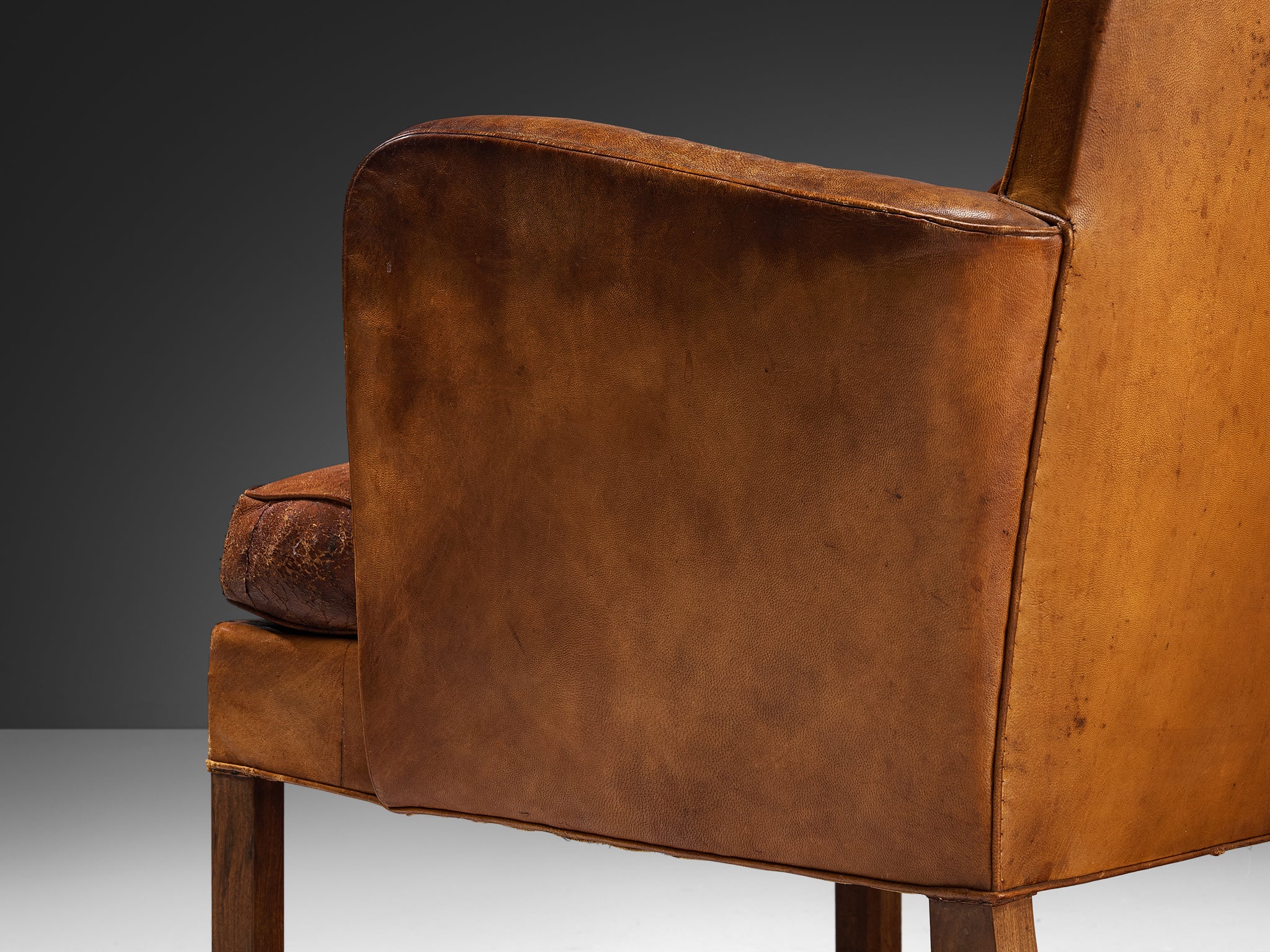
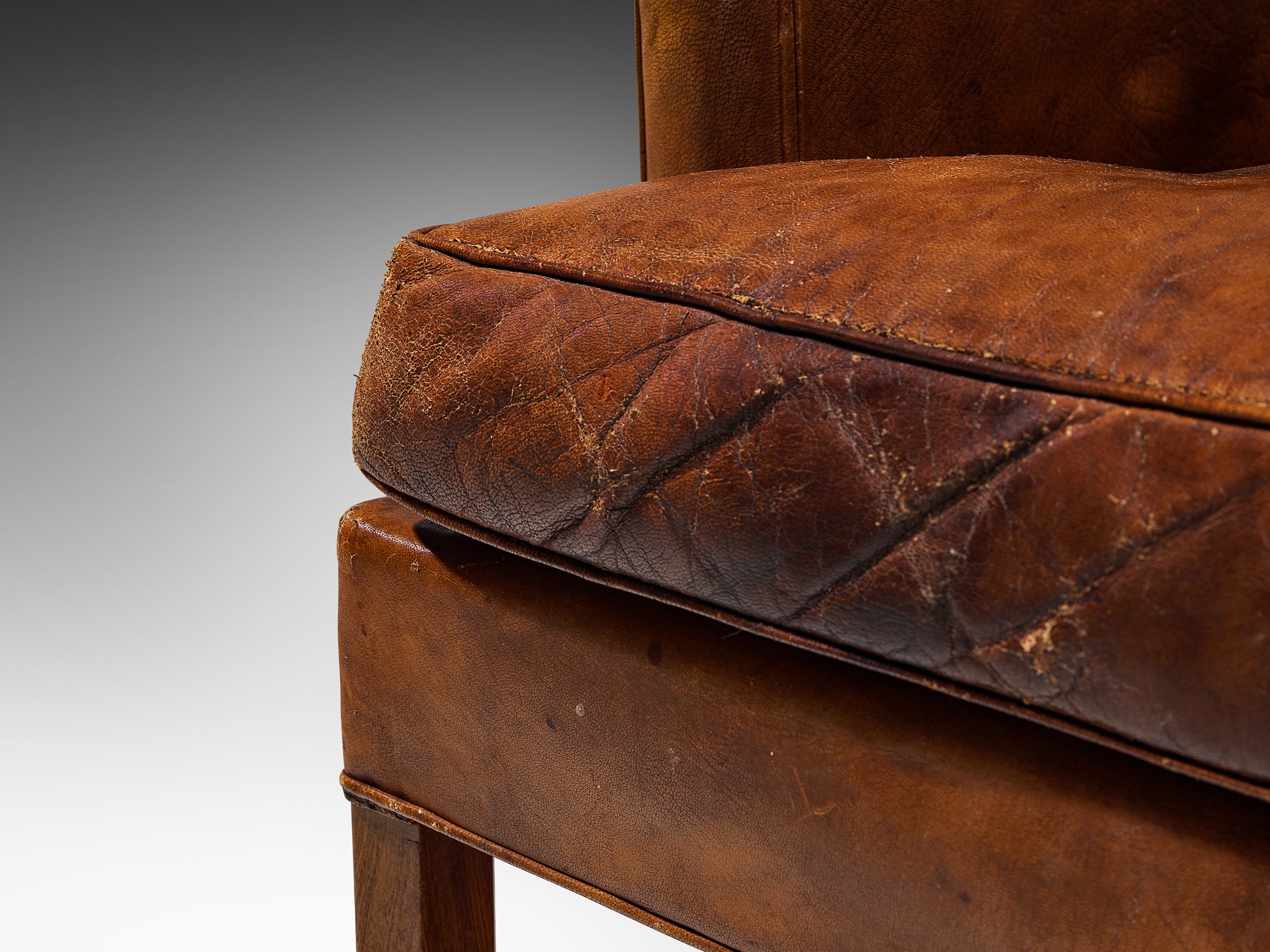
Kaare Klint for Rud Rasmussen Early Easy Chair in Cognac Leather Mahogany
Kaare Klint for Rud. Rasmussens Snedkerier, lounge chair, model ‘5313’, mahogany, original Niger leather, Denmark, design 1934, made 1930s
In the mid-1930s, Kaare Klint submitted a simple but elegant easy chair to an important design competition. The event was organized by the Copenhagen Saddlemakers’ and Upholsterers’ Guild, one of the oldest craft guilds in Denmark. In 1935, they were celebrating their 475th anniversary, and to mark the occasion, they invited 12 architects to take part and submit entries. Klint proposed four different pieces under the code name “Christmas 1934”, including the Red Chair with armrests, the “dressing-gown sofa upholstered in Greek fabric, and a sectional sofa. The chair didn’t actually debut at the guild’s 1935 exhibition, but it ended up being shown later at the Cabinetmakers’ Guild Furniture Exhibition in 1937 in a slightly different form. Yet its roots go back to that moment when Danish designers were rethinking how furniture could fit into modern life without forgetting the values of quality and handcraft. After that, the chair was officially produced by Rud. Rasmussens Snedkerier as model ‘5313’.
Executed in mahogany and original patinated Niger leather, the chair showcases Klint’s signature in designing furniture: combining classical proportions with meticulous attention to detail. The structured yet inviting form displays function and elegance. The gently curved armrests and subtly reclined backrest provide comfort while maintaining formality. The supple leather upholstery, which has developed a beautiful patina over time, enhances its character and warmth. The solid mahogany frame, with its clean lines and precise joinery, reflects the high-quality craftsmanship for which Rud Rasmussen was known. A true modernist masterpiece, this chair is not only a functional piece of furniture but also a symbol of Klint’s influential role in shaping Scandinavian design.
Kaare Klint (1888-1954), born in 1888 in Frederiksburg, Denmark, was a Danish architect and furniture designer. From a young age, Klint was immersed in architecture. His father was the well-known architect Peder Vilhelm Jensen-Klint (1853-1930), who is mainly known for designing the Grundtvigs church in Copenhagen. After studying at the P.S. Krøyer’s Art School from 1907, Klint made his debut as a designer. That year, the Association of Furniture Manufacturers in Copenhagen announced that they would hold a competition for furniture design. Klint submitted, together with Ivar Bentsen (1876-1943), under a code name and together they received first price. In 1924, Klint helped establish the Department of Furniture Design at the Royal Danish Academy of Fine Arts. As associate professor, and later professor, he inspired some of the greatest and most well-known Danish designers, including Hans J. Wegner (1914-2007) and Arne Jacobsen (1902-1971). Klint worked and thought along a few strong principles being the importance of former styles. He believed that the only way forward was to have a deep knowledge of craftsmanship. One of his other core principles was to research functionality and have an outstanding sense for proportion, space and the human body. Overall, Klint drew inspiration from the Shakers, Chippendale and Biedermeier. Kaare Klint's style from the 20s and 30s has had a lot of influence on other designers in both Europe and the United States. Amongst others Børge Mogensen (1914-1972), Finn Juhl (1912-1989) and Poul Kjærholm (1929-1980) have taken influence from Klint. Therefore, Kaare Klint can be seen as the father of Danish mid-century design.
Kindly note that the mahogany used to execute this piece does not require an export license.
In the mid-1930s, Kaare Klint submitted a simple but elegant easy chair to an important design competition. The event was organized by the Copenhagen Saddlemakers’ and Upholsterers’ Guild, one of the oldest craft guilds in Denmark. In 1935, they were celebrating their 475th anniversary, and to mark the occasion, they invited 12 architects to take part and submit entries. Klint proposed four different pieces under the code name “Christmas 1934”, including the Red Chair with armrests, the “dressing-gown sofa upholstered in Greek fabric, and a sectional sofa. The chair didn’t actually debut at the guild’s 1935 exhibition, but it ended up being shown later at the Cabinetmakers’ Guild Furniture Exhibition in 1937 in a slightly different form. Yet its roots go back to that moment when Danish designers were rethinking how furniture could fit into modern life without forgetting the values of quality and handcraft. After that, the chair was officially produced by Rud. Rasmussens Snedkerier as model ‘5313’.
Executed in mahogany and original patinated Niger leather, the chair showcases Klint’s signature in designing furniture: combining classical proportions with meticulous attention to detail. The structured yet inviting form displays function and elegance. The gently curved armrests and subtly reclined backrest provide comfort while maintaining formality. The supple leather upholstery, which has developed a beautiful patina over time, enhances its character and warmth. The solid mahogany frame, with its clean lines and precise joinery, reflects the high-quality craftsmanship for which Rud Rasmussen was known. A true modernist masterpiece, this chair is not only a functional piece of furniture but also a symbol of Klint’s influential role in shaping Scandinavian design.
Kaare Klint (1888-1954), born in 1888 in Frederiksburg, Denmark, was a Danish architect and furniture designer. From a young age, Klint was immersed in architecture. His father was the well-known architect Peder Vilhelm Jensen-Klint (1853-1930), who is mainly known for designing the Grundtvigs church in Copenhagen. After studying at the P.S. Krøyer’s Art School from 1907, Klint made his debut as a designer. That year, the Association of Furniture Manufacturers in Copenhagen announced that they would hold a competition for furniture design. Klint submitted, together with Ivar Bentsen (1876-1943), under a code name and together they received first price. In 1924, Klint helped establish the Department of Furniture Design at the Royal Danish Academy of Fine Arts. As associate professor, and later professor, he inspired some of the greatest and most well-known Danish designers, including Hans J. Wegner (1914-2007) and Arne Jacobsen (1902-1971). Klint worked and thought along a few strong principles being the importance of former styles. He believed that the only way forward was to have a deep knowledge of craftsmanship. One of his other core principles was to research functionality and have an outstanding sense for proportion, space and the human body. Overall, Klint drew inspiration from the Shakers, Chippendale and Biedermeier. Kaare Klint's style from the 20s and 30s has had a lot of influence on other designers in both Europe and the United States. Amongst others Børge Mogensen (1914-1972), Finn Juhl (1912-1989) and Poul Kjærholm (1929-1980) have taken influence from Klint. Therefore, Kaare Klint can be seen as the father of Danish mid-century design.
Kindly note that the mahogany used to execute this piece does not require an export license.
Choose options











Kaare Klint for Rud Rasmussen Early Easy Chair in Cognac Leather Mahogany
Sale price$24,500.00
Regular price
Product Details